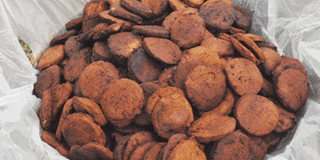Kabalagala, an inevitable “escort”

The brown colour and sweet aroma of kabalagala is inviting. Photo by Ismail Kezaala
What you need to know:
This snack has for long been a delicacy to many Ugandans especially the school going age. Today, kabalagala has evolved to not only have tastier ingredients, but also to attract more affluent people and to be served in uptown eateries.
A stroll around markets, schools or any other place that attracts huge crowds is likely to find the aroma of kabalagala.
Amina Ndagire, who has baked Kabalagala also known as pancake, for the last 20 years, says it become famous during Idi Amin’s regime in the 1970s following the influx of Nubians.
Kasim Kibirige who operates a butchery adjacent to Ndagire’s pancake stall reminisces. “I first tasted kabalagala during break times at school and it has since become part of my breakfast menu,” he says.
Kibirige says back then kabalagala come in a far bigger size than today.
“I think because yellow bananas were abundant then, cassava was not yet affected by wilt and therefore bakers never found it expensive to use more ingredients,” he explains. Owing to their affection for spicy meals, Nubians added pepper to the ingredients while baking kabalagala.
Originally restricted to Zombo, when it was introduced to Buganda, it was named kabalagala (Luganda word for the hot sensation felt when eating peppered food) owing to the pepper-induced bitterness. However, pepper is no longer a popularly used ingredient.
It has since found new names in different regions of Uganda like burahanda (meal that scratches) in Kigezi and obubanda (meal that is flat) in Ankole because of its flat shape.
Rags to riches snack
Kabalagala which started as a low profile snack and was not lucrative as a business, has since evolved into a middle-income business with the snack heavily consumed in upmarket places. Ndagire says kabalagala enjoyed a quick turnaround in fortune during the hard economic times, which were characterised by a lack of confectionaries.
“There was shortage of bread and cakes as sugar (a major ingredient in bread baking was scarce) and people inevitably resorted to locally produced kabalagala,”she adds.
The crisis come as a blessing in disguise as kabalagala quickly evolved from schools and markets and made its way into offices.
More demand meant more people joining the trade and many women who ply this business today joined during the 1970s.
The preparation style of kabalagala has also contributed to the snack surviving the test of time and finding its way to the tables of the affluent.
Natural sweetness
“I think the best thing about kabalagala is that it is prepared without adding sugar. It is safe to be eaten by people who are cautious and choosy about their meals especially due to health reasons,” Ndagire explains.
Sugar is not an ingredient in Kabalagala, but unscrupulous and incompetent bakers add sugar to stir up sweetness.
Now a lucrative trade, many bakers I talked to were reluctant to divulge their recipes for fear of being copied.
Carbohydrates like cassava flour being the main ingredients have kabalagala a highly solid meal which explains its fame among urban -middle income earners and places where one wants a meal to hold up the stomach for long, like market days and political rallies.
“If am not sure when my next meal will be, kabalagala becomes an obvious rescue,” says Baker. The snack however is eaten in morning and evenings for morning and evening tea. Some, however, prefer it without tea.
The blend of yellow bananas and maize flour produces a natural sweet mixture. Ndagire says unlike other meals, appetite for kabalagala does not diminish.
“Because of the less sugar, one is unlikely to become tired of kabalagala,”she says.
So savoury is kabalagala that Ugandans visiting friends and relatives abroad are sure to include it in their luggage.
Going at a relatively pocket friendly price of shs100 each, it explains its popularity in low incomes settings like taxi parks.
It has also managed to flourish for long because there were few alternatives that could be counted as snacks when it was introduced on the Ugandan menu.
However, bread, cakes, boiled cassava and katogo have now become very familiar as a breakfast meals, increasing competition against kabalagala.
Make kabalagala at home
You will need:
• 40-50 fingers of very ripe fresh yellow bananas (amenvu) depending on the amount of kabalagala you want to make.
• Cassava flour
• A rolling pin or bottle
Method
• Peel 40-0 fingers of yellow bananas and mash or pound them into a soft mixture in a basin.
• Add 2 kilos of cassava flour.
• Mix into a dough.
• Roll the dough on a table.
• Cut the dough using a cup or any circular object.
• Dip the cut pieces in boiling cooking oil for 5 -10 minutes until brown.




